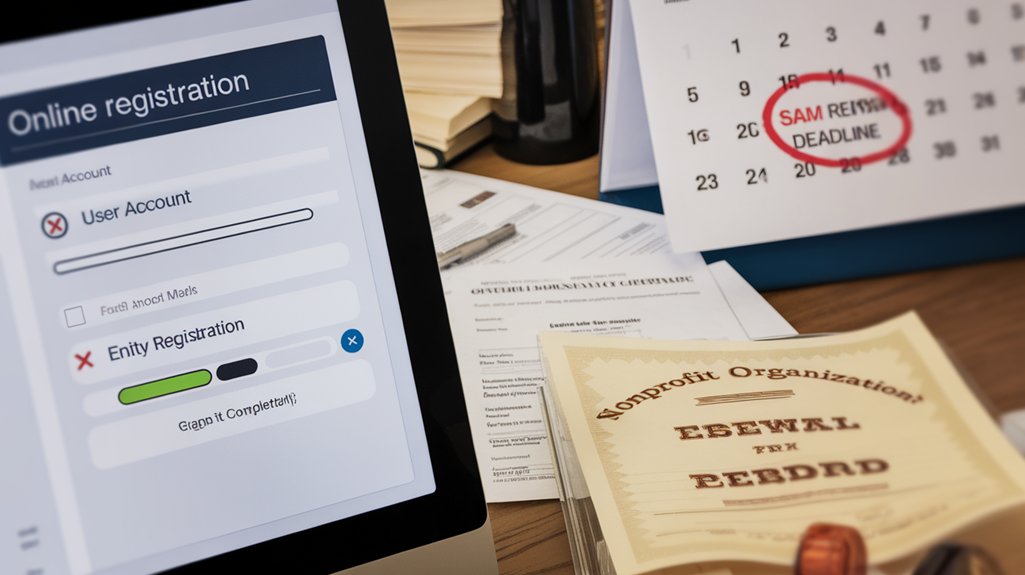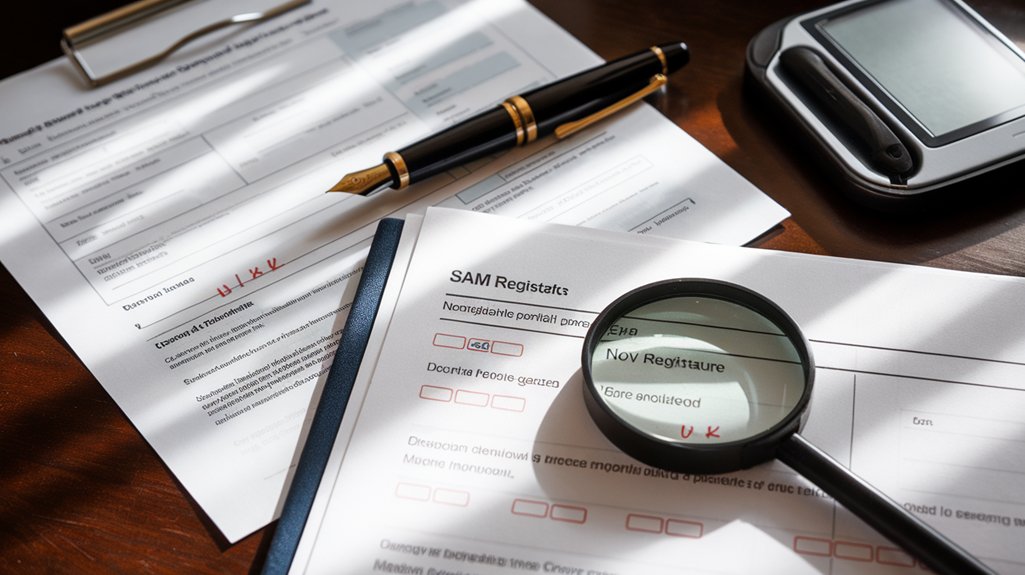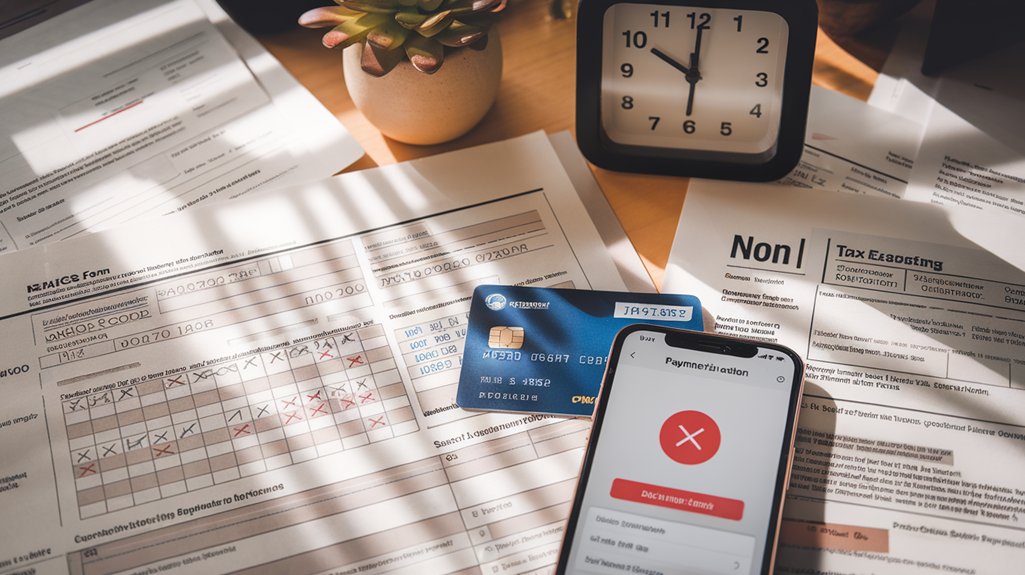Nonprofits frequently make critical SAM registration errors that jeopardize federal funding opportunities. Common mistakes include confusing account creation with full registration, using incorrect business names, submitting incomplete documentation, selecting inaccurate NAICS codes, providing invalid banking details, missing renewal deadlines, and failing to maintain year-round active status. Organizations should begin registration 2-3 months before deadlines, verify all information against IRS records, and implement calendar alerts for renewals. The following sections expose how these errors block access to essential government resources.
Mistaking User Account Setup for Full Entity Registration

Many nonprofit organizations fall into the common trap of confusing user account creation with complete entity registration on SAM.gov, potentially jeopardizing their eligibility for federal funding. This misconception occurs during the initial setup phase, where organizations focus solely on creating individual user profiles rather than completing the thorough entity registration process.
The registration process requires more than just establishing individual accounts. Nonprofits must submit detailed organizational information, including their legal name and address, which should match IRS records. Without full entity registration using their Federal Tax ID, organizations cannot bid on federal contracts or apply for grants. It’s important to note that registering directly on the official SAM website at www.sam.gov is completely free of charge. Thorough preparation of critical documentation before beginning the registration process significantly reduces delays and complications for 501(c)(3) organizations seeking federal resources.
Entity registration demands complete organizational information matching IRS records—not just user accounts—to qualify for federal opportunities.
To avoid this mistake, nonprofits should guarantee they:
- Complete user account setup for staff members
- Assign proper roles to these users, particularly the Agency Administrator role
- Submit thorough entity information through the full registration pathway
- Verify all mandatory fields are completed correctly
Incorrectly Self-Certifying as a Disadvantaged Business

A significant portion of nonprofit organizations unknowingly make critical errors when self-certifying as a Small Disadvantaged Business (SDB) during the SAM registration process, potentially jeopardizing their federal contracting opportunities.
The self-certification process requires strict adherence to federal regulations and accurate eligibility verification to avoid severe consequences.
Common mistakes nonprofits make during self-certification include:
- Misinterpreting nonprofit status as automatically qualifying for SDB designation
- Failing to verify socio-economic status of board members and leadership
- Incorrectly documenting ownership and control structures specific to nonprofit governance
- Overlooking industry-specific size standards that determine small business status
These errors can result in disqualification from contracts, financial penalties, and damage to organizational reputation.
Nonprofits should thoroughly review SDB eligibility criteria before self-certifying, guarantee accurate documentation of control and governance, and consult with professionals experienced in federal contracting if uncertainty exists about qualification requirements. Organizations must provide their legal name exactly as registered with the IRS to avoid registration validation failure. Unlike other certifications such as Veteran-Owned Small Businesses that require formal verification through the VA certification program, SDB status uses a self-certification approach that demands careful attention to eligibility details. Proper SAM registration is essential as it increases visibility to agencies seeking qualified vendors and opens access to set-aside contracts specifically designed for eligible organizations.
Using Fictitious Names Instead of Legal Entity Names

Confusion between a nonprofit’s legal entity name and its fictitious business name represents one of the most common and serious errors during the SAM registration process. Many organizations operate under trade names, “doing business as” (DBA) titles, or abbreviated versions of their official name, leading to critical registration failures.
The legal name importance cannot be overstated—it must precisely match what’s registered with the IRS, including suffixes like “Inc.” or “Foundation.” The SAM system validates this information directly against IRS records, and any discrepancy will prevent registration completion.
Fictitious name risks include:
- Rejection of registration applications
- Delays in obtaining a Unique Entity ID
- Inability to compete for federal grants or contracts
- Potential compliance issues with federal regulations
Organizations should reference their IRS determination letter or tax returns to confirm their exact legal name before beginning the SAM registration process. A comprehensive registration checklist can help nonprofits gather all necessary documentation and ensure accuracy when entering their legal entity information.
Submitting Incomplete or Improperly Signed Documentation

Nonprofits frequently derail their SAM registration process by submitting documentation that lacks required information or proper signatures. Document verification can be delayed or rejected when organizations fail to provide all mandatory materials or when submitted documents contain inconsistencies with SAM.gov entries.
Signature requirements are particularly strict, with many nonprofits overlooking the need for authorized personnel to sign specific forms. To avoid these pitfalls, organizations should guarantee:
- All submitted documents match the registered entity information exactly as it appears in SAM.gov
- Non-English documentation includes properly formatted, self-certified translations with current dates
- Every required signature is present and executed by authorized individuals
- Documents are current and not beyond their validity period
Understanding the federal compliance requirements is essential for nonprofits to successfully navigate the registration system and increase their chances of securing government contracts.
Maintaining an organized filing system for SAM documentation helps nonprofits track submission status and quickly address any Federal Service Desk communications requesting additional information or clarification. This prevents unnecessary delays in the registration process.
Selecting Inaccurate NAICS Codes and Payment Information

Many organizations struggle with selecting appropriate NAICS codes and entering accurate payment information, two critical components that directly impact a nonprofit’s ability to receive federal funding.
NAICS code selection determines which contract opportunities become visible to the organization, with incorrect codes leading to missed opportunities and improper bidding eligibility. The size standards associated with each NAICS code can also affect a nonprofit’s competitive positioning in government contracting spaces. Nonprofits must verify their primary business activities align with chosen NAICS codes and review these periodically to maintain relevance in procurement searches.
Similarly, payment information accuracy directly affects financial operations. Invalid banking details, mismatched account numbers, or incomplete routing information can cause rejected transactions and disrupt cash flow. These payment inconsistencies often result in costly delays and can add several weeks to the overall registration timeline.
Maintaining accurate documentation throughout the process is crucial, as inadequate or outdated paperwork can lead to registration rejection or suspension.
Organizations should implement verification procedures, including:
- Testing payment details with small transactions
- Cross-checking NAICS codes against actual services provided
- Validating that banking information matches IRS records
- Confirming appropriate deposit methods are selected
Overlooking Critical Review Process Timeframes and Deadlines

Punctuality serves as the cornerstone of successful SAM registration for nonprofits seeking federal funding opportunities. Organizations frequently underestimate the complexity of registration timelines, causing eligibility lapses and missed application windows. The validation process involves multiple federal systems working in sequence, not simultaneously.
Time is not just money—it’s eligibility when navigating SAM registration for federal funding access.
Nonprofits should prioritize these critical timeline considerations:
- Initiate registration or renewal 2-3 months before deadlines, as compliance checks intensify during renewal cycles.
- Account for the mandatory 7-10 business day minimum processing period, which extends if IRS/Treasury validations encounter discrepancies.
- Establish calendar alerts that incorporate buffer periods for third-party delays and technical issues.
- Create contingency plans for document requests that may emerge during SAM.gov’s updated verification procedures.
Maintaining registration every 12 months is crucial to avoid interruptions in your organization’s federal funding eligibility.
The role of an EBiz POC is essential during registration as this designated individual must authorize organizational representatives who can submit grant applications.
Following a detailed step-by-step process helps ensure accuracy and efficiency when updating your SAM registration information.
Last-minute submissions risk automatic deactivation in grants.gov systems, effectively eliminating eligibility regardless of program qualifications.
Proactive timeline management prevents the common scenario where qualified nonprofits miss opportunities simply due to administrative delays.
Failing to Maintain Active Registration Status Year-Round

Countless federal funding opportunities slip through nonprofits’ fingers each year due to registration status lapses, creating unnecessary barriers to mission-critical resources.
Organizations often miss the critical 365-day renewal window, triggering automatic deactivation and requiring complete reapplication—a process that can delay funding access for weeks.
Many nonprofits fail to implement robust registration strategies that account for SAM.gov’s renewal reminders being filtered by email systems or overlooked by staff.
Organizations should:
- Calendar multiple renewal alerts beginning 60 days before expiration
- Assign primary and backup registration monitors
- Verify entity information quarterly, especially after leadership changes
- Maintain current documentation for immediate submission
Even temporary lapses can disqualify organizations from grants and cooperative agreements.
Establishing digital tools integration can significantly reduce the risk of missing important renewal deadlines and maintain continuous compliance.
Nonprofits must ensure compliance with federal regulations by maintaining accurate socio-economic status information during the renewal process.
Smart nonprofits treat SAM registration as an ongoing compliance requirement rather than a one-time task, ensuring continuous eligibility for federal funding opportunities throughout the year.
Frequently Asked Questions
Can Nonprofits Qualify for Set-Aside Contracts Like For-Profit Small Businesses?
Nonprofits generally do not qualify for most set-aside contracts designed for for-profit small businesses. Their nonprofit classification typically excludes them from socioeconomic programs like WOSB, VOSB, or 8(a) that require specific ownership structures.
However, limited exceptions exist through specialized programs like AbilityOne for organizations serving people with disabilities.
Nonprofits can still compete as small businesses if they meet SBA size standards, though they should primarily pursue full-and-open competitions or subcontracting opportunities with prime contractors.
How Do International Nonprofits Register in SAM Without US Tax IDS?
International nonprofits face registration challenges when seeking SAM enrollment without US tax IDs.
These organizations should first obtain an NCAGE code, which serves as a primary tax identification alternative. They must guarantee all entity information matches exactly across platforms, including legal name and physical address details.
The registration process requires submission of notarized authorization letters and accurate banking information.
Some international entities may qualify for special considerations if based in EU or NATO countries.
What’s the Process for Updating Board Members After Registration?
Updating board member information in SAM.gov requires a specific process that avoids triggering full registration renewal.
Organizations should log into their entity workspace, select “I would like to update Points of Contact,” and navigate to the Core Data section. The administrator should update the Authorized Entity Administrator role information as needed.
This targeted approach prevents unnecessary IRS/CAGE validation processes. Organizations should prepare a board resolution authorizing these changes and maintain dated proof of board approval for compliance purposes.
Do Church-Affiliated Nonprofits Need Different Documentation for SAM Registration?
Church-affiliated nonprofits generally follow the same SAM registration process as other nonprofits, with some additional documentation requirements.
They should provide their tax exemption letter, articles of incorporation, and potentially proof of church affiliation.
While not requiring a separate process, these organizations may need to submit documentation that verifies their religious affiliation status.
Having these documents prepared in advance will streamline the registration process and prevent delays in obtaining federal funding opportunities.
Can Multiple Chapters of One Nonprofit Use the Same Registration?
No, multiple chapters of one nonprofit typically cannot use the same registration.
For nonprofit compliance, each chapter generally requires its own unique SAM.gov registration with a separate Unique Entity ID (UEI).
This is because chapters often function as distinct entities with their own financial structures and funding streams.
Each chapter must complete individual entity validation processes and maintain accurate documentation of their specific physical address and legal information for proper chapter registration.